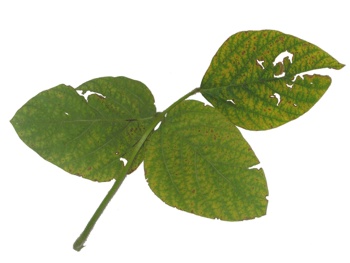Diseases
Ascochyta sojaecola Abramov - Ascochyta Leaf and Pod Spot of Soya
Systematic position.
Class Deuteromycota, superoder Coelomycetes, order Sphaeropsidales, family Sphaeropsidaceae, genus Ascochyta.Synonym.
Ascochyta phaseolorum Sacc.Biological group.
Saprobiont.Morphology and biology.
The fungus Ascochyta soaeicola affects all bodies of plant, i.e., cotyledons, leaves, stems, beans, and seeds. In Primorskii Territory this fungus is an activator of root rot of soya. Depressed spots form on cotyledons, having sometimes concentric zonality, being 3-8 mm in diameter. Sometimes deep through reddish-brown ulcers form on cotyledons and caulicle. The spots are light brown or grayish-white on simple and compound leaves, having sharp brown limb. Light part of the spots drops out later, but the brown limb is kept. Spots of whitish dying tissue form on stems, and the tissue splits into longitudinal strips. Bean valves become moldering and whitish, bearing numerous distinct pycnidia. Seeds in beans are feeble, small, putrescent, and covered with white mycelium with pycnidia. Pycnidia are spherical, dark brown, 90-220 mkm in diameter, sunken in leaf tissue, located in concentric circles. Conidia are numerous, colorless, with one cross septa, cylindrical, with the rounded apices, 9-11 x 3-4.5 mkm in size. Conidia are spread during vegetation season. Sources of the infection are infected vegetation residues and seeds of cultural and wild soya.Distribution.
The fungus is distributed in a number of countries of the Western Europe, in Japan, China, Georgia, Ukraine, Moldova. In Russia it meets in the Far East, Central European part, Northern Caucasus, Krasnodar Territory.Ecology.
High air humidity, rains, and temperature 20-24.C promote the disease development.Economic significance.
The activator of Ascochyta Leaf and Pod Spot of Soya can affect cultural and wild soya (Glycine hispida Max, G. ussuriensis Rgl. et Maack.), Pisum arvense L., Pisum sativum L., and Vicia faba L. It can cause reduction seed germinating ability by 25-40%, losses of shoots and adult plants, reduction assimilating leaf surface, and decrease of grain yield and deterioration of its quality. The yield losses can sometimes reach 15-20% and more. Control measures are crop rotation, autumn plowing to a depth at least 20 cm along with burying of vegetation residues, duly sowing, destruction of wild-growing soya as a source of the infection, duly harvesting and fast drying of sowing material, seed dressing, fungicide spraying of plants during vegetation period, use of resistant cultivars.Related references:
Khokhraykov M.N., Dobrozrakova T.L., Stepanov K.M., Letova M.F. 2003. Keys to plant diseases. Saint-Petersburg: Lan', 592 p. (in Russian).Naumova E.S., Uspenskaya G.D. 1989. Intraspecific diversity of Ascochyta sojaecola Abramov ex Nelen. Mikologiya i fitopatologiya (Leningrad) 23(6): 533-535 (in Russian).
Prostakova Zh.G., Ganya A.I. 1983. Fungal diseases of soybean and their control. Kishinev: Shtiintsa, 35 p. (in Russian).
Zaostrovnykh V.I. 2005. Diseases of soya. Zashchita i karantin rastenii (Moscow) 2: 49-53 (in Russian).


